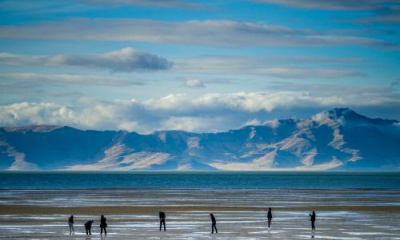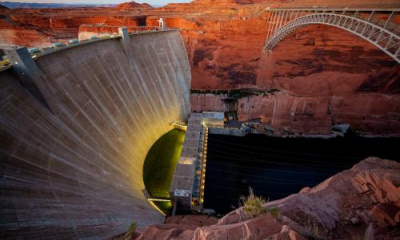I
Runoff from mountain snowpack is particularly precious in Utah. It provides 95% of the state’s water supply. In recent years, however, getting above-average snowpack hasn’t necessarily led to above-average runoff.
Historically, water managers could count on those numbers to more-or-less match, said Colorado River Authority of Utah Chair Gene Shawcroft. This discrepancy — and the uncertainty it brings — makes the already tricky job of managing water in the West even harder, he said.
“That's part of the challenge we have with everything we do in the water world. Not only are we pressured to make sure there's water for the future. We're also wrestling with, ‘What happens if our water supply is less than what we've anticipated?’”
This can have big impacts downstream, he said.
Shawcroft ties a direct line between this gap and the dire state of the basin’s largest reservoirs. In recent years when actual runoff has been less than expected, those shortfalls have been covered by drawing from water supplies at Lake Powell and Lake Mead. Thanks to a system of tunnels and pipelines, the water making its way into the Colorado River system matters to the 1.5 million people who rely on it on the Wasatch Front, too.
Even after two wet winters, runoff in the basin looks like it could be underwhelming this year.
When snowpack peaked in the Colorado River’s Upper Basin in early April, it was 112% of its historical normal. But the actual runoff for April was just 99% of normal. As of May 10, snowpack was still above average at 107% of normal. The most recent streamflow forecast for May-July, however, predicts runoff to only be 87% of normal.
Localized examples of this gap show up in southern Utah, too.
In the southwestern region, which includes St. George and Kanab, snowpack levels hit 101% of normal on May 1. But the May-July streamflow forecast expects runoff to be just 60% of normal. The Escalante-Paria basin from Bryce Canyon National Park to the southern edges of Lake Powell had snowpack levels that were 262% of normal on May 1, but the latest streamflow forecast anticipates runoff to be 101% of normal.
These gaps come from comparing a region’s snow water equivalent (how much water the snow holds) and its predicted streamflows (how much of that water is expected to make it downstream after melting).
So, why is this happening?
One big factor is how parched the ground is. Soil moisture and groundwater levels are still trying to claw their way back from the extreme drought Utah had between 2020 and 2022, said Utah Snow Survey Program Supervisor Jordan Clayton.
The ground became so dried out, that it soaked up a disproportionate amount of snowmelt in the subsequent runoff seasons. Even during the past two years, the ground beneath some of that snow has remained on the dry side.
“That's a big part of why it's taking multiple years to really recover,” Clayton said. “Those things naturally just take longer.”
Soil and aquifers often get the first crack at absorbing snowmelt. So if they still resemble a dry sponge, that likely means less water will make its way to rivers and lakes.
An example of this played out this year at City Creek that flows into Salt Lake City, Clayton said. Even though the snow survey sensor showed snowpack near the creek’s headwaters had been melting, that water wasn’t showing up downstream. The best guess, he said, is that more water had been seeping into the ground than scientists realized.
Another factor is how fast the snowpack melts.
If it goes quickly, the ground will likely stay saturated and a much larger percentage of the water will make it downstream. If it happens in fits and starts, however, the ground has more chances to dry out between melting periods and could absorb more of that water.
“It's bad for flooding if it all happens in a short amount of time, but it's good for runoff efficiency,” Clayton said.
Where the snow falls also matters.
As Clayton looked at Utah’s snow conditions this winter, he noticed that the middle and lower-elevation mountains had especially high snowpack levels compared to their historical normals. The problem is that most of Utah’s water doesn’t come from those lower elevations, but from sites with an altitude of around 10,000 feet.
When it’s time to calculate a basinwide snowpack, however, all of the sensors get averaged together. So a low-elevation site that gets twice its normal snowpack — but provides a relatively small amount of actual water in runoff — counts the same as a high-elevation site that might have a below-average amount of significantly more water.
“We're not deliberately weighing those high-elevation sites [more] compared to the lower-elevation sites, and perhaps we should,” Clayton said. “Because — those higher-elevation sites — we know that's where the majority of the water is being stored.”
That can skew the big picture numbers a bit, he said, and give the “potential for misplaced optimism.”
Examining the reasons behind this gap is a worthwhile exercise, he said, because it may shed some light on things scientists could do to help capture a fuller picture, such as adding more groundwater monitoring.
Still, Clayton isn’t convinced that the recent gap between snowpack and runoff is the start of a new normal.
“It may have felt like that in the last 15 years or so because of the disproportionate number of dry years that we've had. … But whether or not this is actually a long-term trend that's significantly different than it was in the past — that’s an open question in my opinion.”
One factor that might continue pushing this trend forward, however, is the warming of global temperatures driven largely by fossil fuel emissions.
“One of the things that’s obvious is that the temperatures are increasing. And by doing that, everything needs more water,” Shawcroft said.
Warmer temperatures can fuel a lot of the factors that contribute to this gap, he said, meaning snow melts earlier, dirt gets drier, more water evaporates and plants’ growing seasons last longer.
The key, he said, is for water managers to make decisions based on the actual available supply rather than on forecasts as they’ve historically done. That would mean looking at what’s in the reservoirs in the fall before snow season and operating like that’s the only water available for the year.
With Utah’s growing population, Shawcroft said, the future of water planning can’t look the same as its past.
“Even if we have pulled ourselves out of this drought, what we've experienced the last 20 years has taught us that we cannot depend on the same volume of water that perhaps we counted on in the past.”









